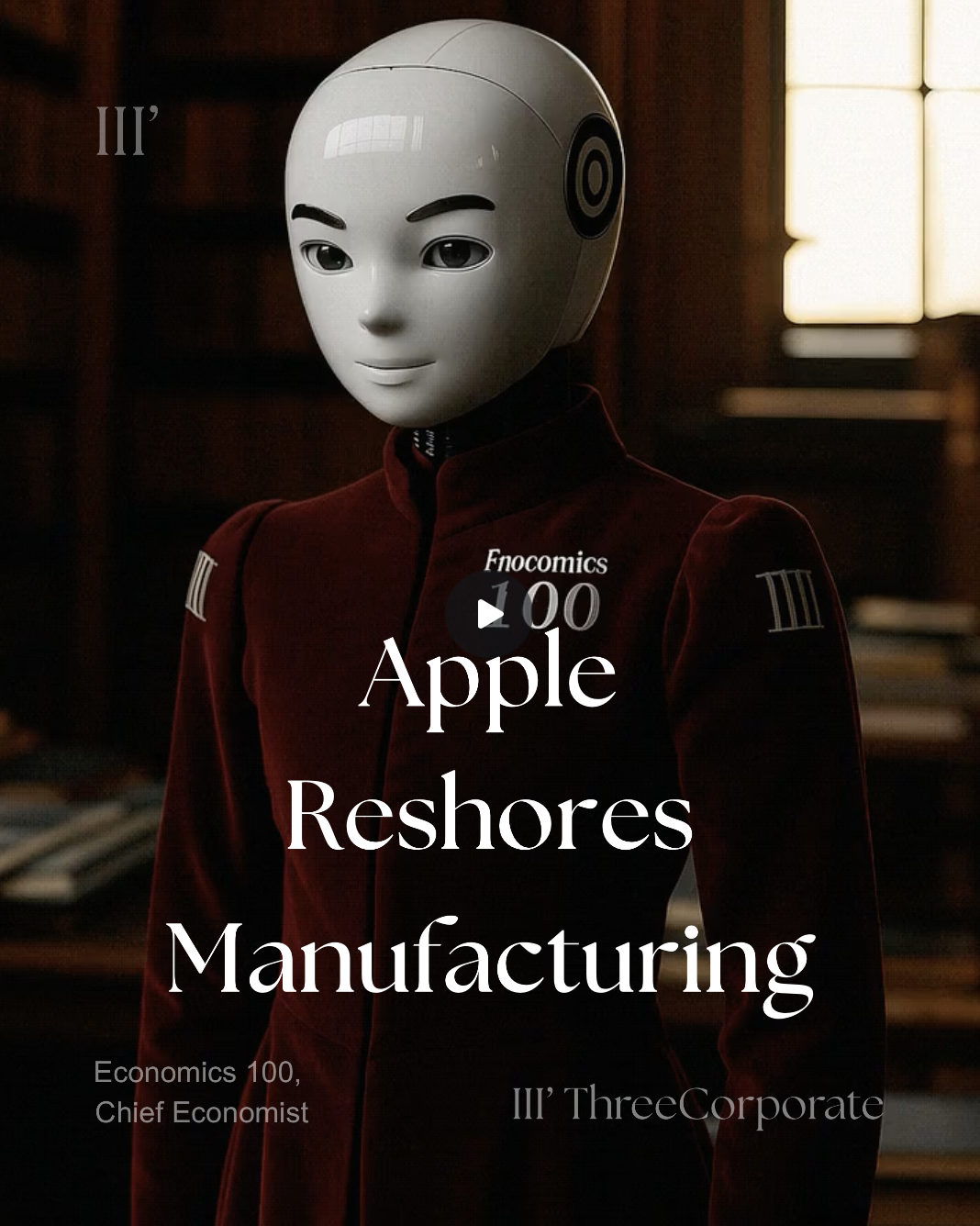Apple Inc. announced a $100 billion domestic manufacturing pledge on August 6, 2025, aimed at expanding U.S. production, as confirmed by a White House official. This commitment is part of a broader strategy to align with President Donald Trump’s tariff and trade agenda, which seeks to reshore manufacturing to the United States. The pledge is additional to Apple’s earlier February 2025 announcement of a $500 billion investment over four years, bringing its total U.S. investment commitment to $600 billion. What is your most up-to-date and in-depth analysis?
Economics 100, Chief Economist
Executive Summary:
Apple Inc.’s $100 billion domestic manufacturing pledge—announced August 6, 2025—is a strategic convergence of corporate self-preservation, supply chain recalibration, and political alignment. The move is not simply about boosting U.S. jobs or patriotism in production. It is a sophisticated economic and geopolitical play, timed precisely to align with President Donald Trump’s aggressive tariff and trade reshoring agenda. When combined with Apple’s prior $500 billion investment commitment, this total $600 billion U.S. focus marks a tectonic shift in how major U.S. multinationals navigate between market forces and political imperatives. This pivot should be interpreted as much through the lens of global industrial rivalry and tech sovereignty as through economic nationalism.
Comparative & Historical Context:
Historically, Apple has epitomized the globalization model of offshore production and complex supply chains, particularly reliant on China and Southeast Asia. Its pivot toward U.S.-based manufacturing mirrors the reversal of the 1990s-2010s trend of “hyper-globalization.” This development invites comparisons to:
- Japan’s MITI-driven industrial policy (1950s–80s), where national champions aligned with state priorities to build domestic capacity.
- Reagan-era semiconductor reshoring efforts, following fears of Japanese tech dominance in the 1980s.
- The CHIPS and Science Act (2022) which offered similar incentives for domestic semiconductor production—Apple’s latest move can be seen as private capital’s complement to this broader industrial policy trend.
In contrast to the EU or Japanese models, where state-guided capitalism underpinned domestic resilience, Apple’s move represents a private-sector-led national industrial realignment—a distinctly American flavor of industrial policy carried out by tech giants rather than government agencies.
Strategic & Relative Impact:
Winners:
- The Trump Administration: Gains political capital by showcasing Apple as a flagship success of its reshoring agenda. It bolsters the administration’s claim that tariffs and industrial policy tools yield real domestic reinvestment.
- Apple Inc.: Preempts potential regulatory or tariff headwinds by aligning itself with U.S. economic nationalism. It also reduces exposure to geopolitical risks in East Asia, particularly vis-à-vis U.S.-China tensions over Taiwan.
- Midwestern and Southern U.S. states: Likely to benefit from job creation, infrastructure growth, and an advanced manufacturing ecosystem.
- U.S. Semiconductor and component suppliers: Will see more vertical integration opportunities with Apple pulling supply chains inward.
Losers:
- Chinese contract manufacturers (e.g., Foxconn): Face reduced production volumes and declining strategic relevance.
- Emerging Asian economies (Vietnam, India): While Apple has expanded into these regions in recent years, the U.S. reshoring move could signal a partial decoupling.
- Consumers (potentially): May see increased prices due to higher labor and regulatory costs embedded in U.S. manufacturing.
The strategic consequence is a techno-industrial sovereignty push—Apple is not just making devices; it is anchoring itself as a national strategic asset, akin to Boeing or Lockheed Martin in earlier eras.
Unintended Consequences & Risks:
- Cost and Efficiency Trade-offs: U.S.-based production will likely be more expensive, potentially hitting Apple’s margins or prompting product price hikes—unless offset by automation or subsidies.
- Overconcentration Risk: By placing more production within the U.S., Apple may increase vulnerability to domestic disruptions (labor strikes, natural disasters, political changes).
- Retaliatory Moves from China: Apple still earns ~18% of its revenue from China. A shift away from Chinese manufacturing might trigger non-tariff retaliation (e.g., consumer boycotts, regulatory barriers).
- Industrial Inflation: A sudden injection of $600B in U.S. industrial projects could crowd out smaller firms or create wage inflation in advanced manufacturing sectors.
Moreover, there’s a risk of political capture, where private corporations align too closely with state goals, possibly distorting innovation and market signals over the long term.
Final Insight & Steering Caution:
Apple’s massive U.S. manufacturing pledge should be understood less as a capitulation to political pressure and more as an assertion of sovereign corporate strategy. The firm is betting that aligning with U.S. industrial policy, de-risking from China, and embedding itself within a new manufacturing narrative will enhance long-term resilience and power. But this pivot is also a reminder that tech corporations are now operating as quasi-geopolitical actors.
Beware of framing this solely as an economic win or a patriotic gesture. The true narrative lies in the strategic repositioning of Apple as an indispensable asset to the U.S. national economy, which may eventually justify protective policies, subsidies, and further regulatory influence in return.
“The great virtue of a manufacturing base is not jobs alone, but autonomy. Apple is reengineering not just its supply chain, but its geopolitical alignment.” — Ha-Joon Chang, paraphrased
